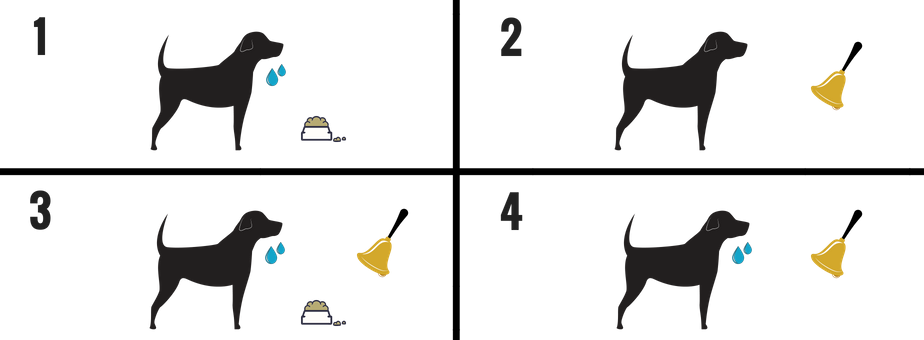.png?width=924&name=Pavlov's%20Hogs%20(1).png)
If you took psychology in high school or college you've probably heard about Pavlov's dogs, but swine are just as suggestible as dogs. With a little creative thinking you can avoid potential training mishaps and prevent your gilts from developing bad habits.
First, a bit on Pavlov's experiment. In the 1890s, Pavlov, a physiologist noticed that dogs in his lab would salivate whenever his assistant walked into the room. This assistant happened to be in charge of feeding the dogs each day. Pavlov knew that the dogs hadn't always salivated when his assistant walked in, but hypothesized that they had developed salivation as a learned response to being fed.
Pavlov then began another experiment where he would ring a bell as he fed the dogs. Within a short period of time he observed that simply ringing the bell, even independent of feeding, would elicit salivation.

If you took psychology in high school or college you've probably heard about Pavlov's dogs, but swine are just as suggestible as dogs. With a little creative thinking you can avoid potential training mishaps and prevent your gilts from developing bad habits.
First, a bit on Pavlov's experiment. In the 1890s, Pavlov, a physiologist noticed that dogs in his lab would salivate whenever his assistant walked into the room. This assistant happened to be in charge of feeding the dogs each day. Pavlov knew that the dogs hadn't always salivated when his assistant walked in, but hypothesized that they had developed salivation as a learned response to being fed.
Pavlov then began another experiment where he would ring a bell as he fed the dogs. Within a short period of time he observed that simply ringing the bell, even independent of feeding, would elicit salivation.

Ironically the easiest animals to initially train, the ones that went through the feed stations first or on their own, developed the worst habits.
Once habits like that set in, it is almost impossible to remove. Most of these sows still trigger when they hear the feed restart and will do so until they are culled from the barn.
How an Ideal Training Works
In an ideal training situation pigs are pushed through the single pass system and only allowed about 5 minutes in the feed station (on day one) before she is asked to leave to allow the next gilt in. The goal with limiting the feeder time to just 5 minutes is that more pigs can get through the stations so that all pigs complete the single pass system well before the 24-hour feed reset.
Once all the animals go through the system for the day, the crowding gates are opened and pigs are allowed to move freely and re-enter the feeders on their own to receive the rest of their daily ration. This shows the pigs that their food source is reliable, and they don't need to be aggressive to get what they want.
As the days go on in training, you can lengthen the time you allow in the feeder until about day four when the gilts can eat their complete ration if they choose. Because of the dosing speed that we use for training gilts, if they eat their full ration, it will take about 15 minutes.
One of the biggest factors is slowly working up to the full 15 minutes so you can ensure there is at least a two-hour time period between when the crowding gates are opened, and the 24-hour feed cycle is restarted. The pigs need that break to keep the gate and feed reset from conditioning them to compete for food.
The Importance of Skip Days
Another way to ensure that pigs don't associate the crowding gates with the feed reset is to incorporate a skip day at around day 5 or 6 in the training. On this day gilts are left to fend for themselves with the ESF system. No one is encouraging them to enter the stations and no crowd gates are present. This is simply to prevent the pigs from learning to wait for a human presence or gate to make them eat.
Similarly, after about eight days of training, producers should retire the single pass system of using crowding gates, so the gilts can learn to manage their time on their own. Hunger is a great motivator for gilts, and they will quickly learn that they don't need to wait to be pushed along to receive feed.
Gilts are curious and intelligent, a lot like man's best friend. Training gilts to use an ESF pen is all about engaging that natural sense of wonder and excitement to learn new skills, and then channeling it in the right direction through healthy conditioning. With an eye on the details and a nod to classical conditioning, we believe preparing gilts can be a rewarding and successful process for all ESF barns.
An Important Note
Not all barns are set up with well designed forward exit ESF system so a single pass training plan may not be possible. This will mean that those working in the barn will have to be aware of the pitfalls of instilling bad habits in whatever form they develop. As we’ve mentioned in numerous blogs, gilts and sows are highly intelligent, highly curious and highly habitual. Any training plan will always create habits whether they are good habits or bad, so it is important to observe and understand the habits you are creating in your girls.





